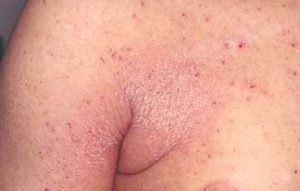Scabies and Treatment : It is usual ectoparasitic infestation triggered by the mite Sarcoptes scabiei that is transferred by close liaison.
The history of discovery of the agent of scabies and of the disease itself is fascinating. In the fourth century BC, Aristotle described scabies and called it Akari, a wound dwelling mite. Napoleon I suffered from scabies. Scabies is described in the Old Testament. Celsus, a physician of Rome, coined the term “scabies” to describe this condition in 1st century AD. It is a Latin word means scratch. The Italian physician Bonoma, explained the conducive agent of scabies, parasitic mite known as Acarus Scabiei / Sarcoptes Scabiei in 1687. According to the ancient Ayurvedic scholar Charaka, the prevention of scabies is by application of turmeric oil, neem oil and regular bath. He also describes animal scabies, today it is called Mange.
Life cycle of Sarcoptes Scabiei:
Sarcoptes Scabiei mites are o.3 to 0.4 mm in size, distributed worldwide. Scabies mites are generally host specific, and Sarcoptes Scabiei is dependent on humans for its lifecycle. Their bodies are enclosed with fine lines and lengthy hairs. They are oval and straw colored. They have short and thick 4 pairs of legs. Females are little bigger than males. Females secrete pheromones – special chemicals to attract males for sex. A newly mated female excavates a tunnel into the outer layers of human skin in 1 to 2 hours. Female burrow the tunnel with her mouth parts, 0.5 to 5 mm per day. While tunneling they suck tissue fluid and eat skin debris. After 2 to 3 days of mating, females lay 1 to 2 eggs per day a week, which hatch into nymphs and later adults. Each tunnel contains only one gravid female. Newly molted adult male and female Sarcoptes come out of tunnel for their sex partners to mate and to continue their progeny. Average 10 to 12 female mites dwell in healthy adults. If more than 12 mites present, than underlying immunodeficiency has to be investigated.
Transmission of scabies:
It is contagious and can be contracted through prolonged physical contact with an infested person. The transfer of a fertilized female to another host results in successful new infection. The prolonged and intimate contact between individuals will happen among household family members, school children, residential hostels, military camps, jail inmates and during sex act. Healthcare staffs are at high risk of developing scabies from patients, as they have close contact with them.
Pathophysiology:
The symptoms are caused by an allergic reaction of the host’s body to mite proteins. The mite feces are taken up by macrophages, processed and presented to Immuno competent cells, which produce IgE antibodies. These antibodies attack the mite and mite fecal matter and produce allergic reactions. Hence to develop antibodies to mite products, it will take 4-6 weeks first time. Subsequent reinfection will result in early symptoms. Hence incubation period is 4-6 weeks.
Signs and symptoms:
The characteristic symptoms of a scabies infection include intense itching and superficial burrows and characteristic distribution of lesions. Rapid involution of lesions occurs following the topical application of effective scabicide. Itching is worse at night. Warm bed and fewer distractions at night, make patient feel more itching. The scabetic burrow may be seen in finger web spaces. Scabetic lesions seen in the interdigital spaces of the fingers, the palms and flexor surface of the wrist. Scabetic lesions are also seen over the medial border of forearm, elbow, anterior axillary fold, nipple and areola in women, periumbilical region, genitalia, anterior thighs, and buttocks. Because of scratching, excoriations are seen, tiny erythematous papules, papulo-vesicles and pustules and crusted lesions are also seen. In adults, scabies spares face and head. In infants, scabies affect face and scalp. Other family members, friends, class mates may show itchy lesions.
In Immuno compromised patients, HIV/ AIDS patients, leprosy patients and cancer patients develop severe scabies called crusted scabies. Neglected scabies patients develop eczema, kidney disease and rheumatic fever.
Treatment:
All family members, all children in the school, all groups should be explained, how scabies spreads, importance of personal hygiene and treatment of all patients at same time. All clothes should be washed and ironed. Heat of iron box will kill scabies mites effectively. Anti-scabies soap, anti-scabies shampoo and anti-scabies lotions are available in the market. Permethrin, 5% lotion is very effective.
Permethrin should be applied below the neck, and bath to be taken after 24 hour. The patient is instructed to take a bath with Anti-scabies soap, scrubbing the areas of greatest involvement, provided these areas are not already excessively irritated. An emulsion containing 5% Permethrin is then applied over the entire cutaneous surface from the neck down, especially between the fingers and toes. It is important to reach all areas, with particularly careful and thorough application to the sites of greatest involvement.
The application is most effectively done by an attendant or some other member of the family, since the patient himself may miss some portions of the body. The patient is instructed not to take bath for succeeding 24 hours. At the end of 24 hours, the patient should take bath, and he should then put on fresh, ironed or dry-cleaned cloths. He should understand that the itching may not be relieved immediately by the treatment, but that its persistence should be regarded as an indication for further application of Permethrin.
- Acarophobia also called parasitophobia will be observed in certain patients who have acquired scabies.
- Antihistamines and antibiotics may be necessary.
- If animals are suffering, then they have to be treated.
- Ivermectin is effective orally in treating scabies.
Dr K Hanumanthayya And Dr Menakaa Mohan
Dermatology













